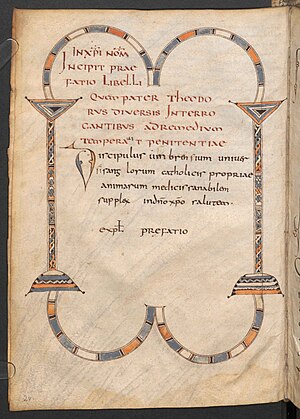Paenitentiale Theodori
| Paenitentiale Theodori | |
|---|---|

Folio 2v from the Vienna manuscript, Lat. 2195, showing the decorative title and dedication of the Umbrense version of the Paenitentiale Theodori
|
|
| Also known as | Iudicia Theodori, Canones Theodori, Discipulus Umbrensium, Canones Gregorii, Capitula Dacheriana, Canones Cottoniani, Canones Basilienses |
| Audience | Catholic clergy |
| Language | medieval Latin |
| Date | ca. 700 |
| Genre | penitential, canon law collection |
| Subject | ecclesiastical and lay discipline; ecclesiastical and lay penance |
The Paenitentiale Theodori (also known as the Iudicia Theodori or Canones Theodori) is an early medieval penitential handbook based on the judgements of Archbishop Theodore of Canterbury. It exists in multiple versions, the fullest and historically most important of which is the U or Discipulus Umbrensium version (hereafter the Paenitentiale Umbrense), composed (probably) in Northumbria within approximately a decade or two after Theodore's death. Other early though far less popular versions are those known today as the Capitula Dacheriana, the Canones Gregorii, the Canones Basilienses, and the Canones Cottoniani, all of which were compiled before the Paenitentiale Umbrense probably in either Ireland and/or England during or shortly after Theodore's lifetime.
It is generally accepted by scholars today that Theodore himself is not responsible for any of the penitential works ascribed to him. Rather, a certain associate of Theodore's named Eoda is generally regarded as the point of dissemination of certain judgements proffered by Theodore in an unofficial context and in response to questions put to him by students at his Canterbury school regarding proper ecclesiastical organization and discipline.
Scholars have for some time accepted that the Capitula Dacheriana represents the earliest attempt to assemble together Theodorian penitential judgments. The case for the Capitula Dacheriana as an Irish production has been argued most effectively by Thomas Charles-Edwards, who noticed, first, that the Capitula Dacheriana lacks any obvious structural framework. For Charles-Edwards, this feature (or rather lack of a feature) is symptomatic of the non-Roman character of the Capitula Dacheriana, and thus suggests its creation outside of Theodore's immediate circle, and perhaps even outside of the Rome-oriented Anglo-Saxon church. Whether or not this is true, there are other, strong signs that the Capitula Dacheriana was produced in ecclesiastical circles that had rather less connection to Theodore's Canterbury than with Irish and Celtic centres. Specifically, the Capitula Dacheriana has both textual and literary connections with eighth-century Irish and/or Breton canonical activities.
The Capitula Dacheriana is witnessed today by two tenth-century manuscripts produced in Brittany. Ludwig Bieler has shown that the copyists of both manuscripts derived their text of the Capitula Dacheriana from the same eighth-century collection of Irish materials that was still resident in Brittany in the tenth century — a collection that also included (or was at least closely associated with) the Collectio canonum Hibernensis. The A-recension of the Collectio canonum Hibernensis, believed to have been compiled before 725, is the earliest work known to have drawn on the Paenitentiale Theodori tradition, relying on none other than the Capitula Dacheriana version. From this it appears that the Capitula Dacheriana was assembled perhaps as early as a decade after Theodore's death (in 690), and certainly no later than the first quarter of the eighth century. It was very possibly compiled in Ireland (though possibly instead in an Anglo-Irish or Breton milieux), and was used shortly after its creation as a source for the Collectio canonum Hibernensis, which would itself (even very soon after its creation) go on to influence powerfully the developing canon law and penitential traditions in Francia.
...
Wikipedia
